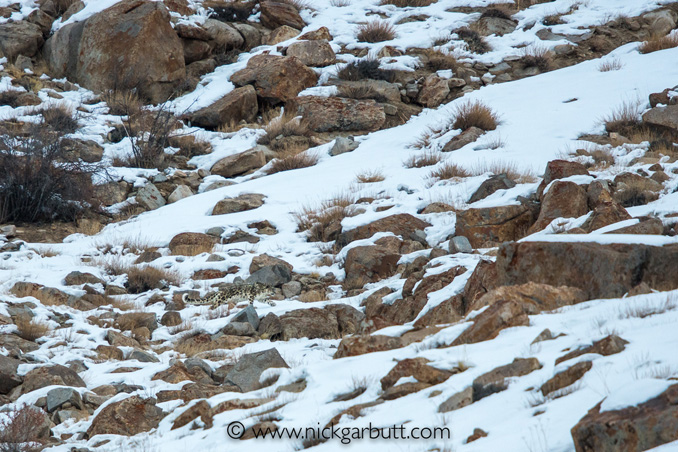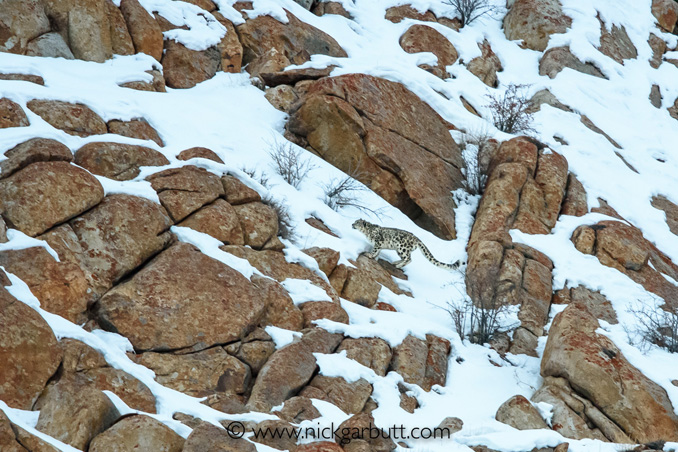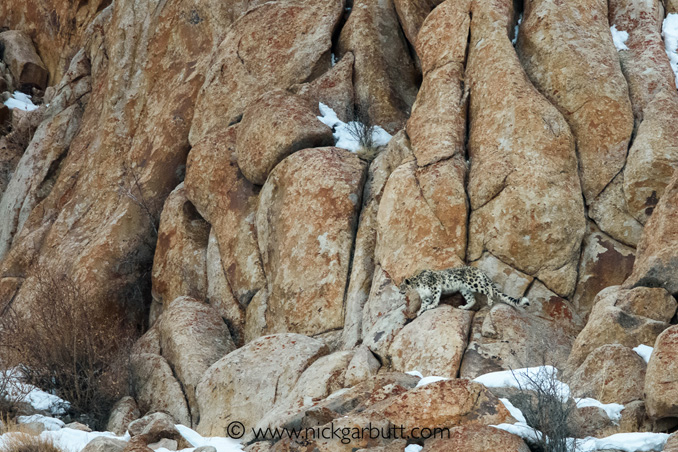
The snow leopard is the epitome of remote, rugged wilderness and has for so long been regarded as a mythical ghost of the mountains: a creature that lives unseen amongst the snow-capped peaks of the Himalayas and Central Asia.
However, over the past decade a handful of locations in the Himalayas have begun to reveal regular and reliable sightings. I have always loved big cats and a life ambition has been to see and photograph them all in the wild: a snow leopard would complete my set, so two years ago I began planning my first trip, from which I’ve just returned.
Winter is the best time to try and see snow leopards as the harsh weather forces grazing and browsing animals like Asiatic Ibex, Urial and Bharal (both types of wild sheep) to lower altitudes. These are the main prey of snow leopards, so they too follow to the lower slopes.

Being well prepared is obviously crucial, especially with the prospect of spending long periods outside in freezing temperatures at higher altitudes. Knowing conditions would be harsh and potentially changeable and likely to range from high winds and blizzards to intense sunshine, I knew good insulation, layering and flexibility would be crucial, so I chose a selection of Páramo gear* to protect me from the elements.
In February this year (2017) I travelled to Ladakh in northern India hoping to fulfil my ambition. After flying into Leh and spending a couple of days acclimatising to the thin air (Leh is around 3,500m asl(11,500 ft)), I travelled on to the Zanskar Range of the Himalayas that lie to the west and my base at the head of a secluded valley lying at around 4,100m (13,500ft). Here, with the help of trackers from the Snow Leopard Conservancy, I was to look for the cats.
Long periods were spent scanning the high slopes on either side of the valley with telescopes. The three guides had remarkable vision and their unaided eyes picked out the movement of ibex on steep snowy cliffs several hundred meters away that I struggled to see with binoculars.
After spending several hours in a side valley, our first sighting came on day three, but it was so distant on a far peak that I struggled to see the animal even through a telescope, let alone take a photo. It wasn’t really what I was after and hardly qualified as the fulfilment of my ambition. The search had to go on.

The next opportunity came two days later. I went out before dawn into the freezing air to set up a time-lapse sequence of the sunrise on the mountains. An hour and a half later, around 7.30am I returned to collect my camera, and suddenly heard the unmistakable call of a snow leopard – a deep guttural meow – coming from high on the ridge to my right. I rushed back to base to find the guides already onto it, tracking the cats’ movements along the ridgeline. The snow leopard was again quite far away, but gradually it moved closer and I was able to take some record shots that at least clearly, but distantly, showed the animal moving across a snow covered slope. Then we saw a second cat and the pair moved further along the ridge together: February and March is mating time and this was almost certainly a courting pair, hence the distinctive calls I had heard earlier.

What turned out to be my final opportunity came three days later. In the afternoon the guides took me higher up the valley to a vantage point where ridges on both sides were visible. Earlier in the day they had found pug marks (foot prints) – almost certainly of the courting pair – and were confident the cats were still somewhere at the head of the valley.

After two hours of combing the slopes using telescopes there were no apparent signs. Undeterred the guides continued their searching and once again began looking closely at the slopes slightly lower down the valley. Ten minutes later they found a snow leopard – probably the male, sitting on a prominent rock overlooking the valley on the opposite side from our position. The guides knew straight away that our best chance of getting closer for photos was to descend back down the valley to an alternative position in anticipation of where the cat was likely to move. I took a couple of distant shots for insurance.
By the time we were back in position lower down, there were two snow leopards visible – the pair were back together and seemed to be playing a game of hide-and-seek amongst the rocks on the ridge. Then the female moved off and disappeared and the male sat for a while looking over the valley. He then climbed down and began descending the slope roughly in a direction towards me. As he picked his way through the boulders and snowy patches it was so difficult to keep track, as his camouflage was so good. Once I’d found him in the viewfinder, I didn’t dare take my eye away from the camera and was able to gradually move with him as he continued to descend.
Gallery: Tracking snow leopards down the slope
Dusk was descending fast, light levels were dropping and the temperature was plummeting, but my adrenaline levels were soaring and hands that had been cold and numb ten minutes earlier were now glowing. I was rattling off volleys of shots as the snow leopard came within perhaps 400m, and then traversed the slope before climbing higher onto another ridge. In the half-light of dusk the last I saw of him was a silhouette on the skyline before he disappeared over the other side.
The final hour had been an intense bout of concentration and excitement. In such instances, I never feel more alive and the feeling is as addictive as any drug. Which is exactly why I intend returning for more.
Nick Garbutt
Nick Garbutt is a UK-based wildlife photographer who organises photography tours and safaris in partnership with Wildlife Worldwide. He will be running snow leopard trips to Ladakh in 2018 and 2019. For more information visit nickgarbutt.com or wildlifeworldwide.com
*Nick packed the following Páramo clothing for the trip:
Bentu Fleece
Torres Alturo Jacket
Torres Medio Gilet
Cascada II Trousers
Quito Trousers
Grid Long Johns






